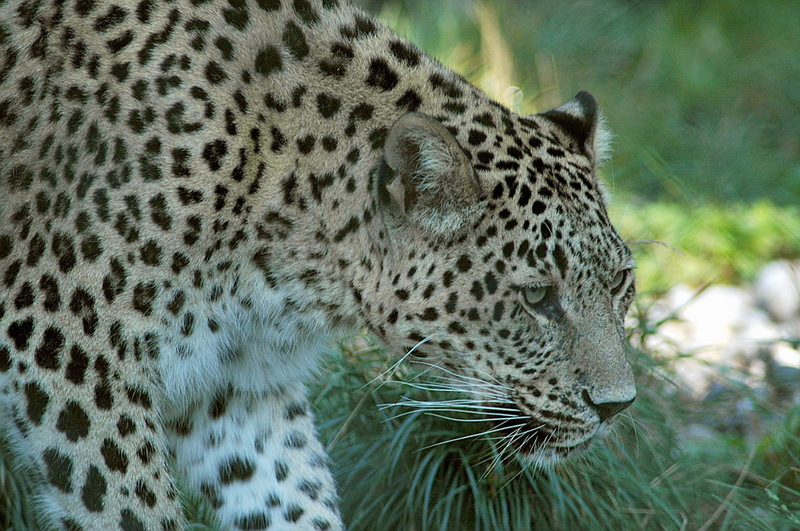Persian Leopard (Panthera pardus saxicolor) - Wiki Persian Leopard
From Wikipedia, the free encyclopedia
[Photo] Nordpersischer Leopard (Panthera pardus saxicolor). Source/Quelle: Fotografiert von Marcel Burkhard http://www.tierlexikon.ch/
The Persian leopard (Panthera pardus saxicolor), or Iranian leopard is one of the leopard subspecies native to western Asia, The Persian leopard is endangered throughout its range in the Middle East.
Description
The Persian leopard is said to be the largest of all the subspecies of leopards in the world. It can grow to up to 1.5 to 2.7 feet tall at the shoulder, and weigh as much as 155 lbs. Before 1990, when Armenia, Azerbaijan, Georgia, Russia, and Turkmenistan were the Soviet republics, the scientific names of the leopard used in these countries were P.p. tulliana and P.p. ciscaucasica, whereas the name P.p. saxicolor had been traditionally used by the western specialists for the cats in Iran and, partially, Afghanistan. There are currently a few hundred left in the world.
Range/Habitat
It is found in Iran, Azerbaijan, Armenia, Turkmenistan, Uzbekistan, Tajikistan, and northwestern Afghanistan. Habitat varies from mountain steppe to grasslands, or anywhere having a reasonable amount of cover and a supply of prey. Unconfirmed reports of big cats in the far southeast of Turkey might also pertain to these animals; see the Caspian Tiger article for details.
Persian Leopard in Armenia
In Armenia, the Persian leopards live in the juniper sparse forests and, to a lesser extent, in arid and mountain grasslands, subalpine and alpine meadows. Their haunts are extremely rough and rocky places with plenty of cliffs. This predator uses the same trails during regular movements, so knowing where they are, the researcher can find the evidence of leopard existence such as scats, tracks and scrapes. The leopard in Armenia is threatened by disturbance, poaching, and wild fire, but which of these factors are most stressful for this cat is still unclear. The leopard can also be found in the Shikahogh State Preserve.
"In Armenia, people and leopards co-exist since the early Holocene and by mid-20th century these big cats were relatively common in the country's mountains. In 1950-1970s, the local leopard population was rising and spreading northwards as shown by increase in the rates of the centrally planned skin purveyance and more skins coming from northern Armenia."
Persian Leopard in Azerbaijan
The Persian leopard lives in the southern regions in Azerbaijan, primarily in the Talysh Mountains, Nagorno-Karabakh and Nakhichevan. Despite occasional sightings, it was not clear whether leopards had been extinct in Azerbaijan by the late 1990s until a species was caught on camera in March 2007 in the Hirkan National Preserve.
Persian Leopard in Georgia
There are very few leopards left in the wild in Georgia. At present, they primarily live in dense forests, although several have been spotted in the lowland plains in the southeastern region of Kakheti in 2004. Over the last 60 years, there have been several sightings of the leopard around the Tbilisi area and in the Shida Kartli province to the northwest of the capital.
Persian Leopard in Iran
The main range of this species in Iran closely overlaps with that of Bezoar Ibex. Hence, it is found throughout Alborz and Zagros mountain ranges, as well as smaller ranges within the Iranian plateau. Leopard population is very sparse, due to loss of habitat, loss of natural prey, and population fragmentation.
Traditionally, large populations were found in northern Khorasan, Golestan, Mazandaran, Gilan, Fars, Ardabil, Kurdistan, Lorestan, West Azarbaijan, Chaharmahal and Bakhtiari, Kohgiluyeh and Boyer-Ahmad, and Esfahan provinces. Leopards do not usually enter the deep desert interior of the country. Apart from Bezoar Ibex, wild sheep, boar, deer (either Maral red deer or roe deer), and domestic animals constitute leoprads' diet in Iran.
Food/Hunting
A leopard's diet varies depending on where it thrives. The Persian leopard's diet varies from small mammals and birds, to larger animals such as, deer, antelope, Bezoar ibex, and occasionally wild boar. The animal silently stalks its prey, and then strikes out of nowhere, ending with a bite to the throat.
Biology
The Persian leopard has a gestation period of 3-4 months. Females reach sexual maturity at about two and a half years of age. The offspring usually consists of 3 cubs.
Threats
This species is listed as endangered and commercial trade of this species is prohibited by international law. The Persian leopard has been threatened due to persecution, habitat loss, and poaching. It is also one of the animals in western Asia which is suffering from warfare in its mountain range.
http://en.wikipedia.org/wiki/Persian_Leopard
| The text in this page is based on the copyrighted Wikipedia article shown in above URL. It is used under the GNU Free Documentation License. You may redistribute it, verbatim or modified, providing that you comply with the terms of the GFDL. |
